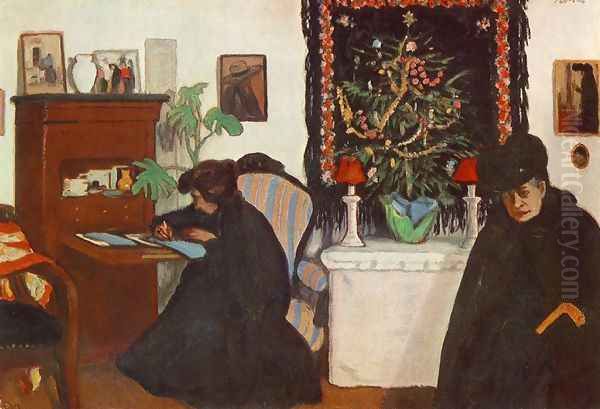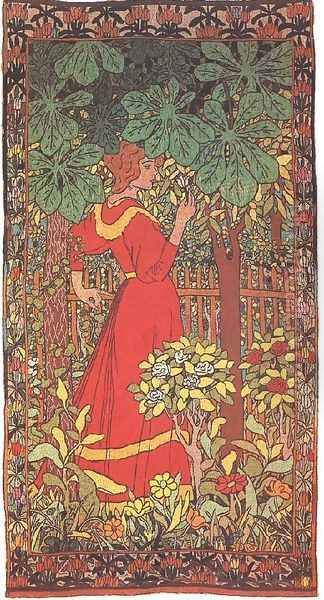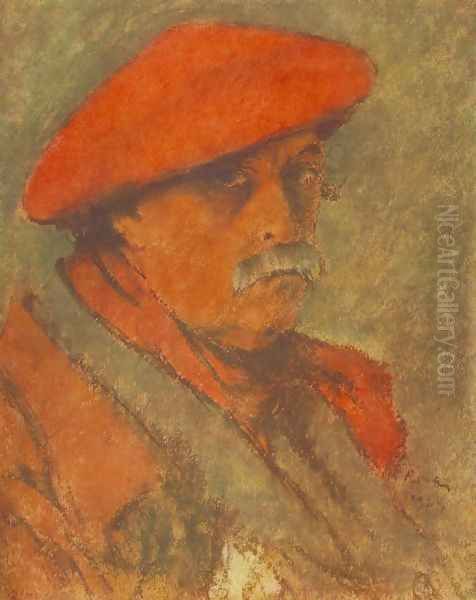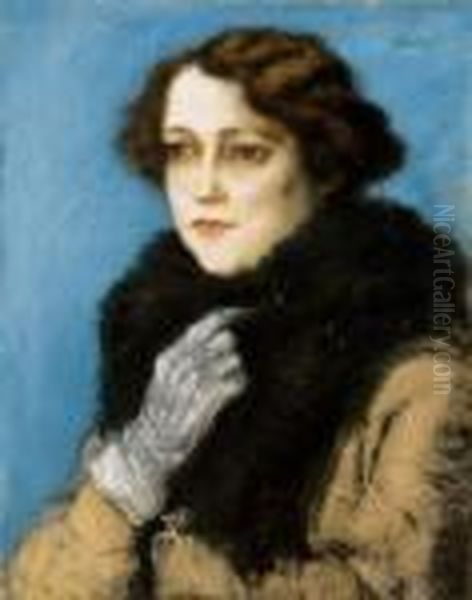
József Rippl-Rónai stands as a towering figure in Hungarian art history, a vital link between the artistic currents of late 19th and early 20th century Paris and the burgeoning modern art scene in his homeland. Born on May 23, 1861, in the provincial town of Kaposvár, Hungary, his journey took him from pharmaceutical studies to the heart of the European avant-garde. He absorbed and synthesized diverse influences, forging a unique style that evolved throughout his career, leaving an indelible mark on painting, design, and the cultural landscape of Hungary. His death on November 25, 1927, marked the end of a prolific and influential life dedicated to art.
Rippl-Rónai's path was not initially set towards art. He first pursued a more practical career, studying pharmacology. However, the pull towards visual expression proved stronger, leading him to abandon his initial path and enroll at the Academy of Fine Arts in Munich. This was a common destination for aspiring artists from Central and Eastern Europe at the time, offering solid academic training. Yet, Munich's traditionalism ultimately couldn't contain his ambition.
The Parisian Crucible: Munkácsy and the Nabis
The pivotal moment in Rippl-Rónai's early career came in 1887 when he moved to Paris, the undisputed capital of the art world. There, he sought out the most famous Hungarian artist of the era, Mihály Munkácsy. Munkácsy, known for his dramatic, dark-toned realist scenes, took Rippl-Rónai under his wing, employing him as an assistant. This period provided invaluable experience and exposure, but Rippl-Rónai soon felt constrained by Munkácsy's established, albeit highly successful, style.
He yearned for something more modern, more personal. This led him away from Munkácsy's orbit and towards the radical innovations happening within the Parisian avant-garde. He found kindred spirits among a group of young artists who called themselves Les Nabis (Hebrew for "prophets"). This group, including figures like Paul Sérusier, Pierre Bonnard, Édouard Vuillard, Maurice Denis, and Aristide Maillol, was deeply influenced by the Synthetism of Paul Gauguin and Émile Bernard.

The Nabis rejected the naturalism of Impressionism, favouring instead flat planes of colour, strong outlines, subjective interpretations of reality, and a decorative approach often infused with Symbolism. Rippl-Rónai formally joined the group, becoming the only non-French member, a testament to his talent and alignment with their artistic ideals. His immersion in this milieu profoundly shaped his artistic direction.
The "Black Period": Symbolism and Intimacy
Rippl-Rónai's work during his early Paris years, roughly from the late 1880s to the mid-1890s, is often referred to as his "Black Period." This designation reflects the dominant tonality of these paintings – characterized by deep, somber colours, often blacks, browns, and grays, applied in broad, flat areas. The influence of the Nabis, particularly their emphasis on simplified forms and emotional resonance over strict realism, is evident.
These works often possess a quiet, introspective, and Symbolist mood. Subjects are frequently drawn from intimate, everyday life, yet imbued with a sense of mystery or melancholy. Figures are often depicted in dimly lit interiors, their forms simplified and their psychological states hinted at rather than explicitly stated. The compositions prioritize decorative arrangement and emotional impact over spatial depth.
A key work from this period is Woman with a Birdcage (1892). The painting depicts a woman, her features somewhat obscured, holding a birdcage. The background is reduced to near abstraction, focusing attention on the central figure and the symbolic potential of the caged bird. The limited palette and flattened perspective create an atmosphere of quiet contemplation and perhaps confinement, typical of Symbolist concerns.
Another significant painting is Inn at Pont-Aven (1894). Pont-Aven in Brittany was a hub for artists, notably Paul Gauguin, whom Rippl-Rónai knew. This work, while depicting a specific location, transcends mere documentation. The dark tones, simplified shapes, and the slightly enigmatic arrangement of figures contribute to a mood that is both specific and universal, hinting at the quiet dramas unfolding within the inn's walls. His connection with Gauguin, though perhaps not intensely collaborative, exposed him directly to one of the most radical forces in Post-Impressionism.
During this time, he also painted portraits, including the striking Portrait with Blue Blouse (c. 1891-1894), depicting Lazarine Baudrion, who would later become his wife. Even within the constraints of the "Black Period" palette, the portrait shows a sensitivity to character and a modern approach to composition, focusing on pattern and silhouette. The influence of James Abbott McNeill Whistler's tonal harmonies can also be discerned in the subtle gradations within the dark palette.
Return to Hungary: New Light, New Colors

Around the turn of the century, Rippl-Rónai began to spend more time back in Hungary, eventually settling permanently in his hometown of Kaposvár in 1902, acquiring a villa (the Villa Róma) which became his home and studio. This move coincided with a significant shift in his artistic style. Leaving behind the predominantly dark palette of his Paris years, he embraced brighter, more vibrant colours and explored different techniques.
This new phase is often called his "Kaposvár" or "Interior" period. His focus remained on intimate scenes, portraits of family and friends, and the domestic environment of the Villa Róma. However, the mood became lighter, the colours more luminous. He began incorporating elements inspired by Impressionism and Post-Impressionism in a more direct way, particularly in his handling of light and colour.
He developed a distinctive technique often referred to as his "kukoricás" or "corn style" (also sometimes translated as "maize style"). This involved applying thick dabs or spots of pure colour, somewhat akin to Pointillism as practiced by Georges Seurat and Paul Signac, but looser and more textured. Instead of aiming for optical mixing from a distance, Rippl-Rónai's technique created a vibrant, tapestry-like surface, full of energy and light. The effect was decorative yet highly expressive.
Works from this period often depict the sun-drenched interiors and garden of the Villa Róma. My Father and Uncle Piacsek Drinking Red Wine (1907) is a prime example. The painting captures a casual, intimate moment with warmth and affection. The figures are rendered with bold outlines and areas of bright, textured colour characteristic of the "corn style." The interplay of light filtering into the room is a key element, rendered through contrasting dabs of paint.
Another notable work reflecting this phase is Christmas (1903). While still an interior scene, the palette is significantly brighter than his earlier work. The composition is rich with decorative patterns found in textiles and wallpaper, reflecting the Nabis' interest in integrating art into everyday life, but now executed with a lighter touch and more vibrant hues. The influence of Art Nouveau's decorative linearity can also be seen in the handling of forms.
Master of Portraiture
Throughout his career, Rippl-Rónai excelled as a portraitist. He captured the likenesses of family members, friends, fellow artists, writers, and prominent figures in Hungarian cultural life. His portraits are rarely mere academic likenesses; they are insightful character studies, rendered with stylistic flair that evolved alongside his overall artistic development.

In his early "Black Period," portraits like the one of Lazarine Baudrion showed his ability to convey personality through subtle means, using silhouette and limited tonal range. Later, in his "corn style," portraits took on a new vibrancy. He painted leading figures of the Hungarian literary scene, such as the poet Endre Ady and the writer Zsigmond Móricz, capturing their intellectual intensity through bold colour and expressive brushwork.
One of his most frequent and compelling subjects in his later years was Elza Bányai, known affectionately as Zorka, who became his model and companion. He painted numerous portraits of her in various settings and moods, often depicted within the colourful interiors of the Villa Róma. These works, such as Woman with Rose (featuring Zorka), showcase the full maturity of his "corn style," with their rich textures, luminous colours, and intimate atmosphere. While some critics noted his intense focus on a single model, these paintings remain powerful explorations of form, colour, and personality.
His Self-Portrait with Red Beret (1924), painted just a few years before his death, is a poignant late work. Rendered in pastel, a medium he increasingly favoured in his later years, it shows the artist looking directly at the viewer with a steady, perhaps slightly weary, gaze. The colours are softer than in his oil paintings, but the characteristic boldness of form remains. It is a frank and dignified self-assessment by an artist nearing the end of his long career.
Beyond Painting: Decorative Arts and Design
Rippl-Rónai's artistic vision extended beyond the canvas. Deeply influenced by the Nabis' philosophy of integrating art into life and the principles of the burgeoning Art Nouveau movement, he actively engaged in the decorative arts. He believed that art should permeate everyday surroundings, breaking down the traditional hierarchy between fine art and applied arts.
Encouraged by his friend, the sculptor and fellow Nabi Aristide Maillol, Rippl-Rónai took up tapestry design. His designs often featured the simplified forms, bold outlines, and decorative patterns characteristic of his paintings, translated into the medium of woven fabric. These works aimed to bring modern artistic sensibilities into the domestic interior.

He also designed furniture, ceramics, and stained glass. One of his most significant commissions in this field was the design of the entire dining room for the Andrássy Palace in Budapest around 1898. This project allowed him to create a complete artistic environment, encompassing furniture, glassware, ceramics, and textiles, all unified by his distinct stylistic vision, which blended Nabis aesthetics with Art Nouveau principles and Hungarian folk motifs. This commission was a landmark achievement in Hungarian applied arts.
His involvement in decorative arts underscores his commitment to modernism not just as a style of painting, but as a comprehensive approach to visual culture. He sought to create a distinctly Hungarian modern aesthetic that was nevertheless connected to the most advanced international trends. His work in design significantly contributed to the development of the Hungarian Secession movement (the local variant of Art Nouveau).
Challenges and Later Years
Life was not without its difficulties for Rippl-Rónai. During World War I, while staying in France, his Hungarian nationality made him an enemy alien. Despite his deep connections to the French art world and friendships with artists like Maurice Denis and Aristide Maillol, he was arrested on suspicion of espionage. He spent several months imprisoned in Mâcon. Although his friends eventually secured his release, the experience was undoubtedly traumatic and disruptive.
After the war and his return to Hungary, he continued to work prolifically, primarily at the Villa Róma in Kaposvár. He increasingly turned to pastels, a medium that allowed for both vibrant colour and a softer touch. His subjects remained focused on portraits, intimate interiors, and the landscapes around his home. He became a respected elder statesman of Hungarian art, a living link to the heroic age of Parisian modernism.
His later works, while perhaps less revolutionary than his Nabis-influenced or "corn style" periods, maintained a high level of quality and personal expression. They often possess a serene, contemplative quality, reflecting a mature artist comfortable with his unique visual language. Though he experimented with ceramics and tapestry again in his later years, these efforts did not achieve the same level of recognition as his paintings or earlier designs.
Artistic Relationships and Influence
Rippl-Rónai's career was shaped by his interactions with numerous artists. His initial apprenticeship with Mihály Munkácsy provided foundational training but also a style to react against. His engagement with the Nabis – Paul Sérusier, Pierre Bonnard, Édouard Vuillard, Maurice Denis, Ker-Xavier Roussel, Félix Vallotton, and Aristide Maillol – was transformative, pushing him towards Symbolism, decorative flatness, and subjective colour. His acquaintance with Paul Gauguin further solidified his move away from academic realism.
He also maintained connections with other international figures like the Scottish artist James Pitcairn-Knowles. While in Paris, he would have been aware of the broader Post-Impressionist landscape, including the works of Vincent van Gogh and Georges Seurat, even if their direct influence is less pronounced than that of the Nabis. The Symbolist paintings of artists like Puvis de Chavannes also formed part of the artistic climate he absorbed.
Back in Hungary, he was a leading figure within the modern art movement, associated with the Nagybánya artists' colony (though not a formal member) and later with the influential "Nyugat" (West) literary and artistic circle. He was a contemporary of other key Hungarian modernists like Károly Ferenczy and Tivadar Csontváry Kosztka, although his style remained distinct. His work provided a crucial bridge, bringing the latest Parisian developments directly into the Hungarian context and inspiring younger generations of artists.
Legacy and Significance
József Rippl-Rónai's legacy is multifaceted. He was a pioneer who introduced Post-Impressionist and Symbolist ideas into Hungarian art, breaking away from the dominant academic and realist traditions represented by figures like Munkácsy. His association with the Nabis gave him unique international standing and infused his work with a sophisticated understanding of modern composition and colour theory.
His stylistic evolution – from the moody depths of the "Black Period" to the vibrant textures of the "corn style" and the softer hues of his late pastels – demonstrates a restless artistic spirit constantly exploring new modes of expression. He successfully synthesized international trends with a personal vision and, particularly in his Kaposvár period, with motifs drawn from his immediate Hungarian environment.
His contributions to the decorative arts were equally significant, positioning him as a key figure in the Hungarian Art Nouveau (Secession) movement and promoting the ideal of the unified work of art (Gesamtkunstwerk). He demonstrated that modern artistic principles could enrich everyday life through thoughtful design.
Today, Rippl-Rónai is celebrated as one of Hungary's most important modern painters. His works are prominently featured in the Hungarian National Gallery and other major collections. He remains admired for his bold use of colour, his innovative techniques, his insightful portraiture, and his crucial role in connecting Hungarian art to the mainstream of European modernism. His journey from Kaposvár to Paris and back again encapsulates a vital chapter in the story of modern art in Central Europe.